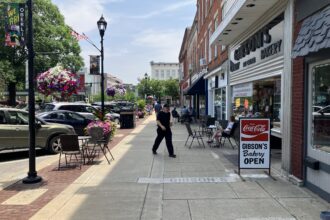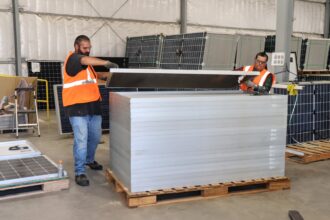Sustainability leaders for Cleveland and three neighboring cities are making progress on cutting greenhouse gas emissions, despite a decade of retrenchment on climate policy at the state level.
Cleveland’s five-year update of its climate action plan will now commit to be net zero by 2050, said Anand Natarajan, assistant director for the Cleveland Mayor’s Office of Sustainability & Climate Justice. He spoke with other city leaders during a September 21 program for the Cleveland 2030 District, a network of urban areas working in public-private partnerships to address climate change, particularly in buildings.
The city’s last plan update, in 2018, called for an 80 percent reduction in greenhouse gas emissions by 2050, which would include a switch to 100 percent renewable electricity by then. The net-zero goal in the 2023-2024 update will thus be more ambitious, and also more science-based, Natarajan said.
Cleveland also has signed onto the Department of Energy’s Better Building Challenge, Natarajan said. The challenge calls for reducing greenhouse gas emissions from buildings by at least 50 percent within 10 years.
Cleveland Heights has added rooftop solar to three of its city buildings and is having energy audits done for all its municipal buildings, said Andy Boateng, the city’s sustainability and resiliency coordinator.
The neighboring city of Shaker Heights already has done audits for its city buildings, said Michael Peters, the sustainability coordinator there, as well as the founder of Sway Mobility, an electric vehicle car-sharing business. Some recent business development has been on land formerly owned by the city, “so we’ve had the ability in development agreements to craft sustainability pledges or efforts,” he added.
Shaker Heights also became Ohio’s first LEED gold city in 2021. One of the rationales for doing that was economic development, Peters said. Participating in the program made it easier for the city to adopt a set of best practices vetted by the U.S. Green Building Council, instead of “reinventing the wheel” on what counts for sustainability, Peters said. Cleveland, Cincinnati and Columbus are part of LEED for Cities and Communities as well.
Just west of Cleveland, Lakewood is among Ohio’s leaders in public electric vehicle charging stations per capita, said Tristan Rader, a Lakewood city council member, who is also Ohio program director for Solar United Neighbors. Planning is also under way for a unified building code that would call for new buildings to be both EV-ready and rooftop solar-ready.
Lakewood also had added more information to its website to help residents and businesses navigate a streamlined permitting process. “The more information we put out there, the easier it will be for people to start those steps to lead a more sustainable life,” Rader said.
Along the same lines, Shaker Heights is working to help residents understand the Inflation Reduction Act’s incentives and rebate provisions for replacing appliances,other equipment and installing solar, Peters said.
Beyond that, “a lot of our climate and energy education is just spending time and convincing people that this is important, that this is real,” Natarajan noted.
Keep Environmental Journalism Alive
ICN provides award-winning climate coverage free of charge and advertising. We rely on donations from readers like you to keep going.
Donate NowA majority in Cuyahoga County—which includes Cleveland, Lakewood, Shaker Heights and Cleveland Heights—believes human activities are causing global warming and that it will harm people in the United States and elsewhere, data from the Yale Program on Climate Change Communication show. But just under half think global warming will harm them personally. And two-thirds rarely or never talk about climate change.
Transportation and Other Challenges
“We want to significantly reduce the vehicle miles traveled within our city” by fossil or diesel-fueled vehicles, Boateng said. To that end, Cleveland Heights has been adding electric and hybrid vehicles for its operations. The city also is building up biking infrastructure and looking at other ways to get around the city.
Rader said there’s talk among Lakewood City Council members about a feasibility study to bring back a “circulator” bus service. A circulator’s route would go around the community, rather than to or from Cleveland, which is the case for a majority of bus routes run by the Greater Cleveland Regional Transit Authority. Cutting emissions from people who drive through the city to and from Cleveland is another challenge, he noted.
Cleveland’s public water system presents more challenges. “It takes a lot of energy” to pump water up from Lake Erie, treat it and then store it until needed, Natarajan said. “We are trying to focus on efficiency…without reducing the volume and the quality of our water.” Water leak prevention also can avoid wasted energy, he noted.
Aging housing stock is also a problem, because poor insulation and other building features lead to wasted energy. “Cleveland has a very high energy burden,” Natarajan said. A household’s energy burden is the share of its income that goes for utility bills.
“We do have a lot of headwind from the state,” Natarajan added. Ohio previously had strong renewable energy and energy efficiency standards, he explained. But they have become “significantly watered down or nonexistent” as a result of legislative actions over the past decade, he said.
Peters said he would prefer to see Ohioans benefitting from the local air quality benefits that come from producing electricity from renewable sources instead of fossil fuels. However, a 2021 state law erected new hurdles for site approvals for new electric generation from solar or wind, but not fossil fuels.
For now, Shaker Heights has been offsetting all of its municipal electricity use with renewable energy credits since 2020, Peters said. But studies have concluded some credits reflect “creative accounting,” with fewer real cuts in greenhouse gas emissions than the amount of credits suggests. Yet another 2021 Ohio law prohibits local cities from banning natural gas hookups in new construction. The law came after natural gas interests worked to block resolutions for 100 percent clean energy in the Cleveland suburbs of Bratenahl and South Euclid.
On the Bright Side
There is some hope at the state level, sustainability leaders said. House Bill 197 would allow some community solar projects where people can lower their electric bills by subscribing to a solar project away from their home.
Such projects can help renters who don’t own their homes, as well as homeowners who can’t afford to put solar panels on their roofs or don’t have a suitable area to do so. About half of Lakewood’s population lives in rented homes, Rader said.
Community solar also fits with Cleveland’s equity goals, Natarajan said. “We wanted to be able to provide renewable energy not just for people who can afford it, but for people who cannot.”
Another pending bill would let utilities set up voluntary energy efficiency programs again and recoup capped monthly costs from ratepayers, with lower expectations for efficiency than before House Bill 6 took effect.
Shaker Heights, Cleveland Heights, Cleveland and Lakewood are among the 40-plus communities that have joined Power a Clean Future Ohio. The coalition provides resources to help member communities reduce greenhouse gas emissions, based on their individual priorities.
Additional resources may soon come from NOPEC, the Northeast Ohio Public Energy Council. A new program with World Kinect Energy Services will help six communities develop sustainability roadmaps and implement them, said Chuck Keiper, NOPEC’s executive director. The goal is eventually to offer the service to all of the 200-plus cities and towns for which NOPEC provides community aggregation services for supplying natural gas and electricity generation.
In Natarajan’s view, cutting emissions, improving resilience, and other sustainability efforts are not just about numbers, but about making life better for all who live, work and commute to Cleveland. “Quality of life—it all comes back to that for us,” he said.










